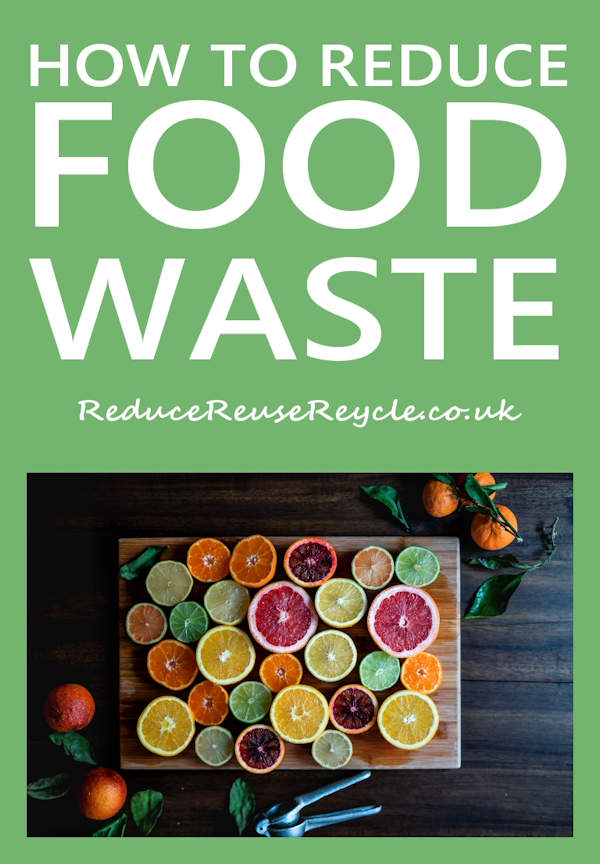How To Reduce Food Waste

Image Credit: Edgar Castrejon
According to The Food Standards Agency, 7 million tonnes of wasted food is thrown away in the UK every year, at an estimated cost per household of £470.
Yet the majority of this food could have been eaten, so what can we do to bring this figure down?
The most important way to reduce this figure is by reducing the amount of waste food each of us produces.
Reduce The Amount Of Food That You Waste
Firstly, you can reduce the amount of food that you waste by only buying the amount of food that you actually need. However tempting that BOGOF offer might seem, you don't save money if you buy food that just ends up going in the bin.
You can reduce the amount of waste by:-
- Careful meal planning: There is a vast amount of resources available for free or at varying costs on how to plan meals, but basically meal planning means making a list of the all the meals that you intend to cook for the week and then writing down a shopping list of the ingredients that you need to buy for them.
- Using this shopping list when you go to buy food or place your order online, rather than buying a random bunch of stuff and hoping that you still can put together a meal by the end of the week. As a bonus, if you don't keep having to go shopping for forgotton ingredients, it removes the temptation to buy extra food - which will save you money as well.
- Check use-by dates and make sure that all your food is eaten up by that date.
Reuse Food That has Not Been Eaten
There is lots of information available for learning about using up leftover food.
The first place you should visit is the Love Food Hate Waste website which is produced by The Waste and Resources Action Programme (WRAP). It has lots of excellent articles about how to avoid food waste, from how to measure out the correct portions of food, how to understand food date labelling and lots of recipes for using up your leftovers.
Recycle Anything Else
There will always be some leftovers, whether it be potato peelings, used teabags or that tiny bit that could not be eaten.
Much of the food waste that currently goes to landfill could have been composted. Any cooked or raw vegetable and fruit matter can be composted, so that includes apple cores, banana skins, potato peelings, onion skins and even your limp lettuce and squashy tomatoes (mind you I always chop up and hide sad-looking salad in casseroles). You can also compost eggshells and the shells of nuts.
Many local councils offer composters at very compettive rates to residents, or you can see the different types of composters here.
Have A Nice Cup Of Tea

Image Credit: Steve Buissinne
Like many people, I assumed for a very long time that teabags were still made from paper and so were completely biodegradable.
WRONG.
The vast majority of teabags sold in the UK include some nylon in the the material of the bag, which means that they will not break down when composted. The best thing to do is to split open the bags (when the teabag has cooled down of course!) remove the leaves and throw away the bag in your household waste.
If you don't want to do that you could, of course, start using loose tea in an old fashioned teapot, or use an infuser.
This shocking article by green blogger Linday Miles of Treading My Own Path describes her investigations into just how many brands of teabag contain plastic. Although she lives in Australia the brands are nearly all those available in the UK.
What About Non-Compostable Food?
Meat, fish and dairy items cannot go into an ordinary compost heap. They will not break down and will probably attract vermin. So what can you do with the rest?
Most local councils now collect food scraps as part of their household recycling collections. If your council does this they will provide you with a kitchen caddy to save your scraps in, and some councils may also accept food waste in their recycling sites. If you do not have a compost heap you can include all your vegetable matter in them as well.
What happens to your food waste after it is collected? It will composted using a closed vessel, which will heat the food until it breaks down, whereafter it can be used as a soil improver. You can find out more about this from the Food Waste Network
If your local council does not collect food scraps, or you want to compost all your own food waste you can use a Bokashi Bin. Yes, every bit of food can be composted in a Bokashi bin - fish, meat, bones, fruit, veg and dairy. You simply put your food in the bin and add Bokashi bran, which contains 'Effective Microrganisms' to break down the food. Once it is broken down (in about two weeks) it can be used as a soil improver or added to a compost heap to accelerate composting.
Read More
- How To Recycle Coffee Pods and Capsules
- Where Can I Recycle Glass
- Does Anywhere Still Collect Plastic Milk Bottle Tops For Recycling?
What's New
- Environmental Days In January 2026
- Free Water Saving Devices For UK Residents
- STOP! Don't Put That In The Recycling!
- 21 Free Online Games About The Environment For Kids
- Best Plastic-Free Wet Wipes 2026
Most Popular in Recycling
CDs & DVDs
Videotapes & Cassettes
Duvets & Pillows
Ink Cartridges
Shredded Paper
Stamps
......Recycling A-Z
